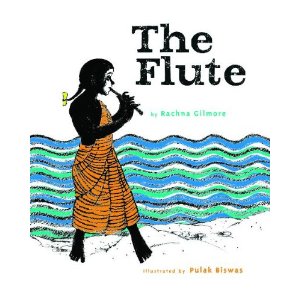Contribute
| Book Review - The Flute |
Tara Menon
09/27/2012
by Tara Menon
Rachna Gilmore, the recipient of Canada’s Governor-General’s award and author of numerous children’s book, has given us a made-up folktale in The Flute. Everything about The Flute is simple: the prose, the stereotypical characters that people folktales, and even the plot that contains fabulist elements. The story concerns a little girl obsessed with the flute that her mother gave her. The Flute makes use of a simple formula -- a child and her favored object. Crockett Johnson uses it in his famous classic, Harold and The Purple Crayon, and Gilmore, like him, imbues the possession with magical properties. Johnson’s book, however, is much more simple and is for younger children whereas Gilmore’s targets children between the ages of six and eight.
The narrative begins as many a story all over the world starts, “Long ago and far away in a village on the banks of a rushing river, a baby girl was born.†The mother calls the girl Chandra, after the moon. She cherishes her daughter and plays the wooden flute to her. “She played of shimmering hot days and the richness of the earth. She played of the cool evening sky and the growing promise of the moon.†The family’s happiness comes to an end when catastrophe strikes in the form of a monsoon that causes the river to overflow. In this poignant scene, the mother hoists Chandra onto the tallest tree. She hands her the flute, which will be the last thing she ever gives her daughter as she and her husband are swept away by the flood. Chandra survives, but her life changes dramatically. Her cruel uncle and aunt take her in, only to overburden her with the care of their cows. Her cousins taunt her. Chandra is even denied the comfort of the wooden flute as her uncle tosses it into the river. However, the flute refuses to abandon her and helps her in ingenious and magical ways that carry the story forward. The predictable ending of the good heroine triumphing over adversities doesn’t diminish the reader’s enjoyment.
Pulak Biswas, the illustrator, who has won many awards, stays faithful to the traditional depiction of the folksy theme. He strives for a stark graphic look by using black and white in his pictures, except for the vivid blue of the river and the bold red of the girl’s dress and ribbon. I wonder, though, if a more colorful rendering coupled with intricate details might have added depth to the simple text.
The plain elements of the folktale make it a universal story. Other than her name, Chandra could stand for any little brave girl, the village could be any village in a tropical country that has a riverbank, the good father and mother any good set of parents, and the wicked uncle and aunt any wicked relatives. The message of resilience and hope in The Flute makes it valid for any culture and any time. The story also shows the power of music to transform and transcend our experiences, albeit in a fabulist fashion. In spite of its virtues, however, The Flute doesn’t measure up to Gilmore’s other creation, Lights for Gita, which remains my favorite picture book for the Diwali season. The Flute is not as memorable though it contributes to the vast sea of folklore.
You may also access this article through our web-site http://www.lokvani.com/
